Trends and Variability of Ozone Pollution over the Mountain-Basin Areas in Sichuan Province during 2013–2020: Synoptic Impacts and Formation Regimes
Abstract
:1. Introduction
2. Materials and Methods
2.1. Surface Ozone Observations and Reanalysis Dataset
2.2. Meteorological Data and Weather Classification
2.3. Numerical Model Description and Simulations
3. Results and Discussion
3.1. Seasonal Variations and Trends of Ozone
3.2. Synoptic Impacts on Daily Variations of Ozone
3.3. Formation Regimes of Ozone at Different Pollution Levels
4. Conclusions
Supplementary Materials
Author Contributions
Funding
Data Availability Statement
Acknowledgments
Conflicts of Interest
References
- Lefohn, A.S.; Malley, C.S.; Smith, L.; Wells, B.; Hazucha, M.; Simon, H.; Naik, V.; Mills, G.; Schultz, M.G.; Paoletti, E.; et al. Tropospheric ozone assessment report: Global ozone metrics for climate change, human health, and crop/ecosystem research. Elem. Sci. Anthr. 2018, 6, 1. [Google Scholar] [CrossRef] [PubMed] [Green Version]
- Berman, J.D.; Fann, N.; Hollingsworth, J.W.; Pinkerton, K.E.; Rom, W.N.; Szema, A.M.; Breysse, P.N.; White, R.H.; Curriero, F.C. Health benefits from large-scale ozone reduction in the United States. Environ. Health Perspect. 2012, 120, 1404–1410. [Google Scholar] [CrossRef]
- Malley, C.S.; Henze, D.K.; Kuylenstierna, J.C.I.; Vallack, H.W.; Davila, Y.; Anenberg, S.C.; Turner, M.C.; Ashmore, M.R. Updated global estimates of respiratory mortality in adults ≥30 years of age attributable to long-term ozone exposure. Environ. Health Perspect. 2017, 125, 087021. [Google Scholar] [CrossRef] [Green Version]
- Avnery, S.; Mauzerall, D.L.; Liu, J.; Horowitz, L.W. Global crop yield reductions due to surface ozone exposure: 2. Year 2030 potential crop production losses and economic damage under two scenarios of O3 pollution. Atmos. Environ. 2011, 45, 2297–2309. [Google Scholar] [CrossRef]
- Yue, X.; Unger, N.; Harper, K.; Xia, X.; Liao, H.; Zhu, T.; Xiao, J.; Feng, Z.; Li, J. Ozone and haze pollution weakens net primary productivity in China. Atmos. Chem. Phys. 2017, 17, 6073–6089. [Google Scholar] [CrossRef] [Green Version]
- Massey, S.W. The effects of ozone and NOx on the deterioration of calcareous stone. Sci. Total. Environ. 1999, 227, 109–121. [Google Scholar] [CrossRef]
- Cooper, O.R.; Gao, R.-S.; Tarasick, D.; Leblanc, T.; Sweeney, C. Long-term ozone trends at rural ozone monitoring sites across the United States, 1990-2010. J. Geophys. Res. Atmos. 2012, 117, 117. [Google Scholar] [CrossRef]
- Chang, K.-L.; Petropavlovskikh, I.; Cooper, O.R.; Schultz, M.G.; Wang, T.; Helmig, D.; Lewis, A. Regional trend analysis of surface ozone observations from monitoring networks in eastern North America, Europe and East Asia. Elem. Sci. Anthr. 2017, 5, 5. [Google Scholar] [CrossRef] [Green Version]
- Lu, X.; Zhang, L.; Wang, X.; Gao, M.; Li, K.; Zhang, Y.; Yue, X.; Zhang, Y. Rapid increases in warm-season surface ozone and resulting health impact in China Since 2013. Environ. Sci. Technol. Lett. 2020, 7, 240–247. [Google Scholar] [CrossRef]
- Lu, X.; Zhang, L.; Chen, Y.; Zhou, M.; Zheng, B.; Li, K.; Liu, Y.; Lin, J.; Fu, T.-M.; Zhang, Q. Exploring 2016–2017 surface ozone pollution over China: Source contributions and meteorological influences. Atmos. Chem. Phys. 2019, 19, 8339–8361. [Google Scholar] [CrossRef] [Green Version]
- Zhao, Q.; Bi, J.; Liu, Q.; Ling, Z.; Shen, G.; Chen, F.; Qiao, Y.; Li, C.; Ma, Z. Sources of volatile organic compounds and policy implications for regional ozone pollution control in an urban location of Nanjing, East China. Atmos. Chem. Phys. 2020, 20, 3905–3919. [Google Scholar] [CrossRef] [Green Version]
- Li, K.; Jacob, D.J.; Liao, H.; Shen, L.; Zhang, Q.; Bates, K.H. Anthropogenic drivers of 2013-2017 trends in summer surface ozone in China. Proc. Natl. Acad. Sci. USA 2019, 116, 422–427. [Google Scholar] [CrossRef] [Green Version]
- Wang, T.; Xue, L.; Brimblecombe, P.; Lam, Y.F.; Li, L.; Zhang, L. Ozone pollution in China: A review of concentrations, meteorological influences, chemical precursors, and effects. Sci. Total. Environ. 2017, 575, 1582–1596. [Google Scholar] [CrossRef]
- Lu, X.; Ye, X.; Zhou, M.; Zhao, Y.; Weng, H.; Kong, H.; Li, K.; Gao, M.; Zheng, B.; Lin, J.; et al. The underappreciated role of agricultural soil nitrogen oxide emissions in ozone pollution regulation in North China. Nat. Commun. 2021, 12, 5021. [Google Scholar] [CrossRef] [PubMed]
- Yang, X.; Wu, K.; Wang, H.; Liu, Y.; Gu, S.; Lu, Y.; Zhang, X.; Hu, Y.; Ou, Y.; Wang, S.; et al. Summertime ozone pollution in Sichuan Basin, China: Meteorological conditions, sources and process analysis. Atmos. Environ. 2020, 226, 117392. [Google Scholar] [CrossRef]
- Lu, N.; Zhang, X.; Kang, P.; Hua, M.; Du, Y.; Chen, J.; Xiang, W.; Lei, Y.; Ou, Y. Objective weather classification and typical process analysis of ozone polltion during spring in Chengdu Plain urban agglomeration. Acta Sci. Circumstantiae 2021, 41, 1610–1627. [Google Scholar]
- Zhan, C.-C.; Xie, M.; Fang, D.-X.; Wang, T.-J.; Wu, Z.; Lu, H.; Li, M.-M.; Chen, P.-L.; Zhuang, B.-L.; Li, S.; et al. Synoptic weather patterns and their impacts on regional particle pollution in the city cluster of the Sichuan Basin, China. Atmos. Environ. 2019, 208, 34–47. [Google Scholar] [CrossRef]
- Wu, K.; Kang, P.; Wang, Z.; Gu, S.; Tie, X.; Zhang, Y.; Wen, X.; Wang, S.; Chen, Y.; Wang, Y.; et al. Ozone temporal variation and its meteorological factors over Chengdu City. Acta Sci. Circumstantiae 2017, 37, 4241–4252. [Google Scholar]
- Chengdu Daily, Chengdu Issues First Emergency Plan for Severely Polluted Ozone Weather in China. 2021. Available online: http://www.sc.xinhuanet.com/content/2021-07/07/c_1127630509.htm (accessed on 7 July 2021).
- Lu, X.; Zhang, L.; Shen, L. Meteorology and climate influences on tropospheric ozone: A review of natural sources, chemistry, and transport patterns. Curr. Pollut. Rep. 2019, 5, 238–260. [Google Scholar] [CrossRef] [Green Version]
- Liang, Z.; Gu, T.; Yang, X.; Du, R.; Zhong, H.; Qi, B. Study on circulation classification based surface ozone concentration prediction model. China Environ. Sci. 2017, 37, 4469–4479. [Google Scholar]
- Kim, H.C.; Lee, D.; Ngan, F.; Kim, B.-U.; Kim, S.; Bae, C.; Yoon, J.-H. Synoptic weather and surface ozone concentration in South Korea. Atmos. Environ. 2021, 244, 117985. [Google Scholar] [CrossRef]
- Li, P.; Xiao, T. The diffusion and transport of PM2.5 under the polluted weather conditions during autumn and winter seasons in Chengdu. China Environ. Sci. 2020, 40, 63–75. [Google Scholar]
- Zhang, Y.; Wang, S.; Ni, C.; Zhang, X.; Jia, X.; Feng, X. Study on an objective synoptic typing method for air pollution weather in Chengdu during winter. Environ. Sci. Technol. 2020, 43, 139–144. [Google Scholar]
- Xu, J.; Chang, L.; Ma, J.; Mao, Z.; Chen, L.; Cao, Y. Objective synoptic weather classification on PM2.5 pollution during autumn and winter season in Shanghai. Acta Sci. Circumstantiae 2016, 36, 4303–4314. [Google Scholar]
- Zhang, Y.; Wang, S.; Jia, X.; Lian, J.; Zhang, X.; Yang, X. Study on an objective synoptic typing method for air pollution weather in North China during winter half year. Acta Sci. Circumstantiae 2018, 38, 3826–3833. [Google Scholar]
- Yang, X.; Zhang, X.; Kang, Y.; Zhang, Y.; Wang, S.; Li, Z.; Li, H. Circulation weather type classification for air pollution over the Beijing-Tianjin-Hebei region during winter. China Environ. Sci. 2017, 37, 3201–3209. [Google Scholar]
- Zhao, J.; Wang, C. Objective synoptic weather classification on air pollution during winter seasons in Hangzhou. J. Atmos. Sci. Res. 2021, 4, 4. [Google Scholar] [CrossRef]
- Shen, L.; Mickley, L.J.; Tai, A.P.K. Influence of synoptic patterns on surface ozone variability over the eastern United States from 1980 to 2012. Atmos. Chem. Phys. 2015, 15, 10925–10938. [Google Scholar] [CrossRef] [Green Version]
- Ning, G.; Yim, S.H.L.; Yang, Y.; Gu, Y.; Dong, G. Modulations of synoptic and climatic changes on ozone pollution and its health risks in mountain-basin areas. Atmos. Environ. 2020, 240, 117808. [Google Scholar] [CrossRef]
- Shen, H.; Sun, Z.; Chen, Y.; Russell, A.G.; Hu, Y.; Odman, M.T.; Qian, Y.; Archibald, A.T.; Tao, S. Novel method for ozone isopleth construction and diagnosis for the ozone control strategy of Chinese cities. Environ. Sci. Technol. 2021. [Google Scholar] [CrossRef]
- Jin, X.; Holloway, T. Spatial and temporal variability of ozone sensitivity over China observed from the Ozone Monitoring Instrument. J. Geophys. Res. Atmos. 2015, 120, 7229–7246. [Google Scholar] [CrossRef]
- Li, Q.; Zhang, L.; Wang, T.; Wang, Z.; Fu, X.; Zhang, Q. “New” reactive nitrogen chemistry reshapes the relationship of ozone to Its precursors. Environ. Sci. Technol. 2018, 52, 2810–2818. [Google Scholar] [CrossRef]
- Xue, T.; Zhu, T.; Zheng, Y.; Liu, J.; Li, X.; Zhang, Q. Changes in the number of PM2.5-attributed deaths in China from 2000 to 2010: Comparison between estimations from census-based epidemiology and pre-established exposure-response functions. Environ. Int. 2019, 129, 430–437. [Google Scholar] [CrossRef] [PubMed]
- Geng, G.; Xiao, Q.; Liu, S.; Liu, X.; Cheng, J.; Zheng, Y.; Xue, T.; Tong, D.; Zheng, B.; Peng, Y.; et al. Tracking air pollution in China: Near real-time PM2.5 retrievals from multisource data fusion. Environ. Sci. Technol. 2021, 55, 12106–12115. [Google Scholar] [CrossRef]
- Xue, T.; Zheng, Y.; Geng, G.; Xiao, Q.; Meng, X.; Wang, M.; Li, X.; Wu, N.; Zhang, Q.; Zhu, T. Estimating spatiotemporal variation in ambient ozone exposure during 2013-2017 using a data-fusion model. Environ. Sci. Technol. 2020, 54, 14877–14888. [Google Scholar] [CrossRef]
- Xiao, Q.; Zheng, Y.; Geng, G.; Chen, C.; Huang, X.; Che, H.; Zhang, X.; He, K.; Zhang, Q. Separating emission and meteorological contributions to long-term PM2.5 trends over eastern China during 2000–2018. Atmos. Chem. Phys. 2021, 21, 9475–9496. [Google Scholar] [CrossRef]
- Xiao, Q.; Geng, G.; Liang, F.; Wang, X.; Lv, Z.; Lei, Y.; Huang, X.; Zhang, Q.; Liu, Y.; He, K. Changes in spatial patterns of PM2.5 pollution in China 2000-2018: Impact of clean air policies. Environ. Int. 2020, 141, 105776. [Google Scholar] [CrossRef]
- Geng, G.; Zhang, Q.; Tong, D.; Li, M.; Zheng, Y.; Wang, S.; He, K. Chemical composition of ambient PM2.5 over China and relationship to precursor emissions during 2005–2012. Atmos. Chem. Phys. 2017, 17, 9187–9203. [Google Scholar] [CrossRef] [Green Version]
- Yang, X.; Lv, Y.; Wang, Y.; Qiao, Y.; Zhang, G.; Wang, S.; Zhang, X.; Liu, Z.; Liu, Y.; Zhu, X. Impact of synoptic patterns on regional ozone pollution in Sichuan Basin. China Environ. Sci. 2021, 41, 2526–2539. [Google Scholar]
- Couto, A.; Costa, P.; Simões, T. Identification of extreme wind events using a weather type classification. Energies 2021, 14, 3944. [Google Scholar] [CrossRef]
- Du, X.; Yang, J.; Zhao, X.; Cheng, X.; Zhu, M. Analysis on correlations between weather classification and air quality during autumn and winter in Chengdu. Environ. Sci. Manag. 2021, 46, 58–62. [Google Scholar]
- Hsu, C.-H.; Cheng, F.-Y. Synoptic weather patterns and associated air pollution in Taiwan. Aerosol Air Qual. Res. 2019, 19, 1139–1151. [Google Scholar] [CrossRef] [Green Version]
- Kidson, J.W. An analysis of New Zealand synoptic types and their use in defining weather regimes. Int. J. Climatol. 2000, 20, 299–316. [Google Scholar] [CrossRef]
- Compagnucci, R.H.; Richman, M.B. Can principal component analysis provide atmospheric circulation or teleconnection patterns? Int. J. Climatol. 2008, 28, 703–726. [Google Scholar] [CrossRef]
- Huth, R.; Beck, C.; Philipp, A.; Demuzere, M.; Ustrnul, Z.; Cahynova, M.; Kysely, J.; Tveito, O.E. Classifications of atmospheric circulation patterns: Recent advances and applications. Ann. N. Y. Acad. Sci. 2008, 1146, 105–152. [Google Scholar] [CrossRef] [PubMed]
- El-Kadi, A.K.A.; Smithson, P.A. Atmospheric classification and synoptic climatology. Prog. Phys. Geogr. 1992, 16, 432–455. [Google Scholar] [CrossRef]
- Huth, R. An intercomparison of computer-assisted circulation classification methods. Int. J. Climatol. 1996, 16, 893–922. [Google Scholar] [CrossRef]
- Huth, R. A circulation classification scheme applicable in GCM studies. Theor. Appl. Climatol. 2000, 67, 1–18. [Google Scholar] [CrossRef]
- Paschalidou, A.K.; Kassomenos, P.A. What are the most fire-dangerous atmospheric circulations in the Eastern-Mediterranean? Analysis of the synoptic wildfire climatology. Sci. Total. Environ. 2016, 539, 536–545. [Google Scholar] [CrossRef]
- Du, Y.; Huang, R.; Wang, X.; Qin, M.; Zhang, W.; Zhang, Y.; Yang, Y.; Zhang, W.; Luo, B.; Hu, Y.; et al. Implementing reduced formed model to construct ozone isopleths and its application. Acta Sci. Nat. Univ. Pekin. 2021, 57, 311–321. [Google Scholar]
- Cohan, D.S.; Hakami, A.; Hu, Y.; Russell, A.G. Nolinear response of ozone to emissions: Source apportionment and sensitivity analysis. Environ. Sci. Technol. 2005, 39, 6739–6748. [Google Scholar] [CrossRef] [PubMed] [Green Version]
- Napelenok, S.; Cohan, D.; Hu, Y.; Russell, A. Decoupled direct 3D sensitivity analysis for particulate matter (DDM-3D/PM). Atmos. Environ. 2006, 40, 6112–6121. [Google Scholar] [CrossRef]
- Byun, D.; Schere, K.L. Review of the governing equations, computational algorithms, and other components of the Models-3 Community Multiscale Air Quality (CMAQ) modeling system. Appl. Mech. Rev. 2006, 59, 51–77. [Google Scholar] [CrossRef]
- Hakami, A.; Odman, M.T.; Russell, A.G. High-order, direct sensitivity analysisi of multidimensional air quality models. Environ. Sci. Technol. 2003, 37, 2442–2452. [Google Scholar] [CrossRef] [PubMed]
- Yang, Y.-J.; Wilkinson, J.G.; Russell, A.G. Fast, direct sensitivity analysis of multidimensional photochemical models. Environ. Sci. Technol. 1997, 31, 2859–2868. [Google Scholar] [CrossRef]
- Pinder, R.W.; Gilliam, R.C.; Appel, K.W.; Napelenok, S.L.; Foley, K.M.; Gilliland, A.B. Efficient probabilistic estimates of surface ozone concentration using an ensemble of model configurations and direct sensitivity calculations. Environ. Sci. Technol. 2009, 43, 2388–2393. [Google Scholar] [CrossRef]
- Zhang, W.; Trail, M.A.; Hu, Y.; Nenes, A.; Russell, A.G. Use of high-order sensitivity analysis and reduced-form modeling to quantify uncertainty in particulate matter simulations in the presence of uncertain emissions rates: A case study in Houston. Atmos. Environ. 2015, 122, 103–113. [Google Scholar] [CrossRef]
- Jerrett, M.; Burnett, R.T.; III, C.A.P.; Ito, K.; Thurston, G.; Krewski, D.; Shi, Y.; Calle, E.; Thun, M. Long-term ozone exposure and mortality. N. Engl. J. Med. 2009, 360, 1085–1095. [Google Scholar] [CrossRef] [Green Version]
- Turner, M.C.; Jerrett, M.; Pope, C.A., 3rd; Krewski, D.; Gapstur, S.M.; Diver, W.R.; Beckerman, B.S.; Marshall, J.D.; Su, J.; Crouse, D.L.; et al. Long-term ozone exposure and mortality in a large prospective study. Am. J. Respir. Crit. Care Med. 2016, 193, 1134–1142. [Google Scholar] [CrossRef] [PubMed] [Green Version]
- 2-min Gridded Global Relief Data (ETOPO2) v2c. National Centers for Environmental Information, National Oceanic and Atmospheric Administration. 2006. Available online: http://www.ngdc.noaa.gov/mgg/fliers/06mgg01.html (accessed on 22 July 2021).
- Zhao, P.; Liu, J.; Luo, Y.; Wang, X.; Li, B.; Xiao, H.; Zhou, Y. Comparative analysis of long-term variation characteristics of SO2, NO2, and O3 in the ecological and economic zones of the western Sichuan Plateau, Southwest China. Int. J. Environ. Res. Public Health 2019, 16, 3265. [Google Scholar] [CrossRef] [Green Version]
- Qi, D.; Li, Y.; Liu, K. Relationship between the drought and flood intensity in Sichuan area in summer and west pacific subtropical high. Plateau Mt. Meteorol. Res. 2012, 32, 41–46. [Google Scholar]
- Wang, X.; Fu, T.M.; Zhang, L.; Cao, H.; Zhang, Q.; Ma, H.; Shen, L.; Evans, M.J.; Ivatt, P.D.; Lu, X.; et al. Sensitivities of ozone air pollution in the Beijing-Tianjin-Hebei area to local and upwind precursor emissions using adjoint modeling. Environ. Sci. Technol. 2021, 55, 5752–5762. [Google Scholar] [CrossRef] [PubMed]
- Gridded Population of the World, Version 4 (GPWv4): Population Count, Revision 11, Center for International Earth Science Information Network (CIESIN) Columbia University 2018. Available online: https://sedac.ciesin.columbia.edu/data/set/gpw-v4-population-count-rev11 (accessed on 22 July 2021).

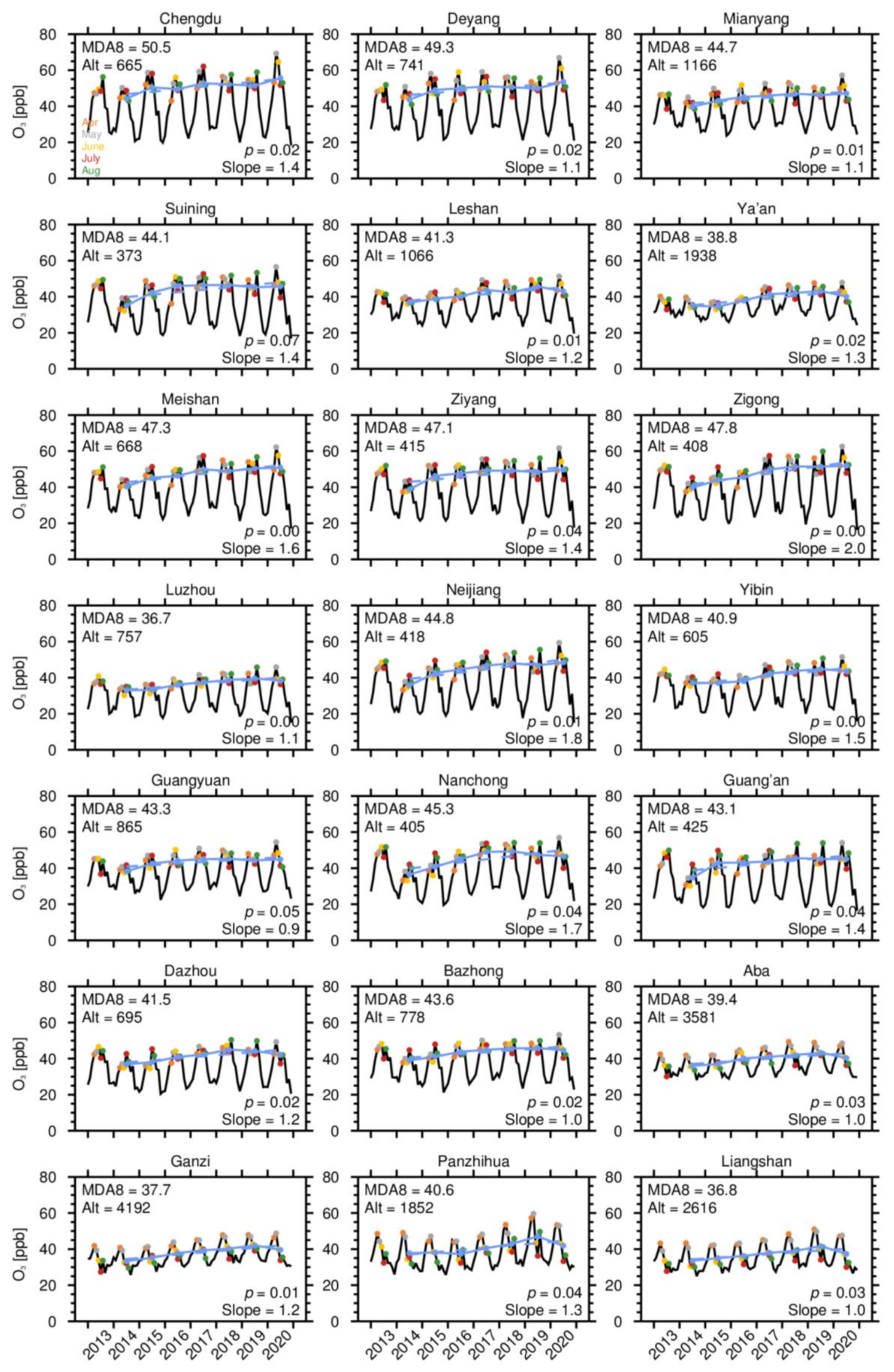
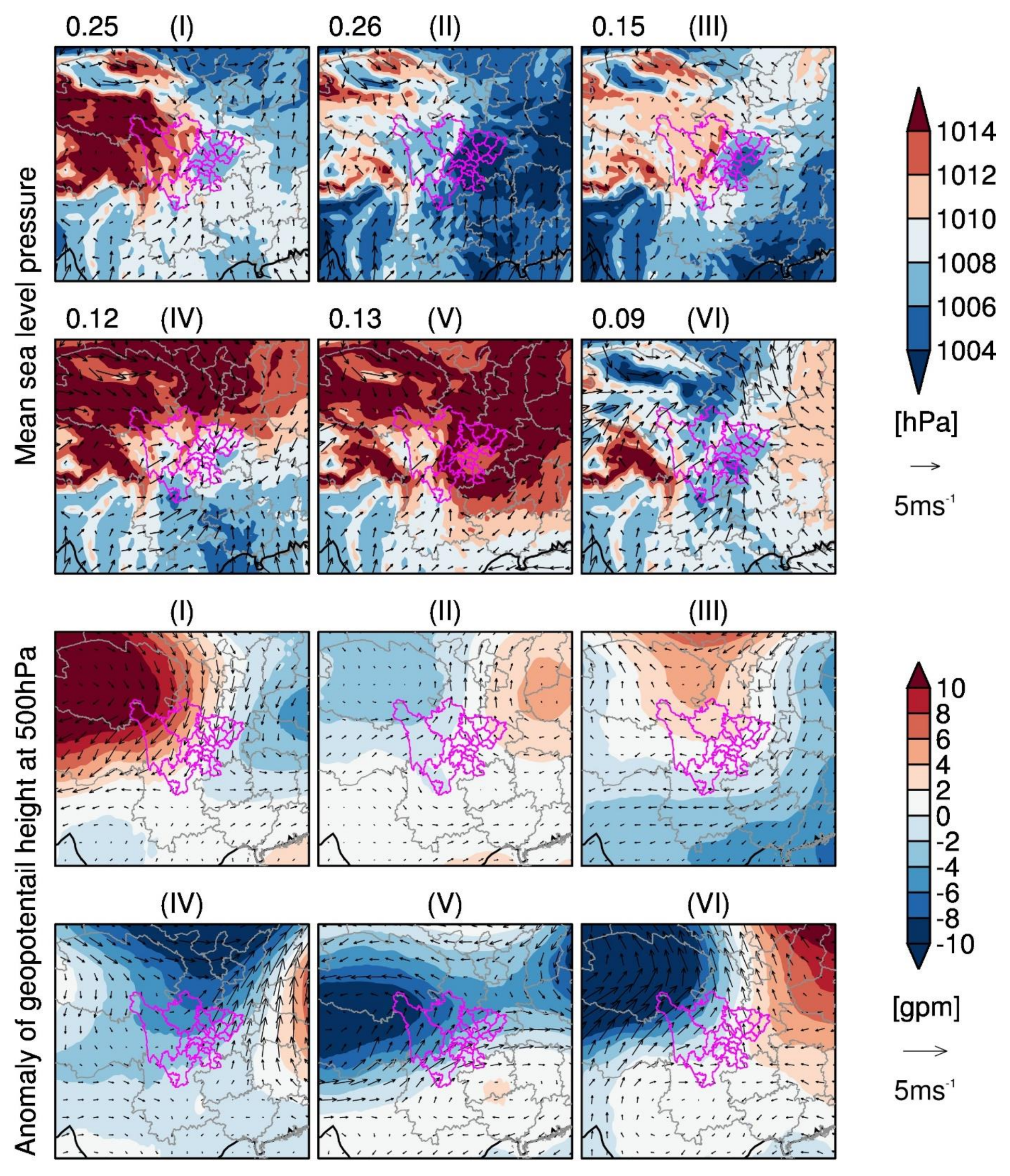
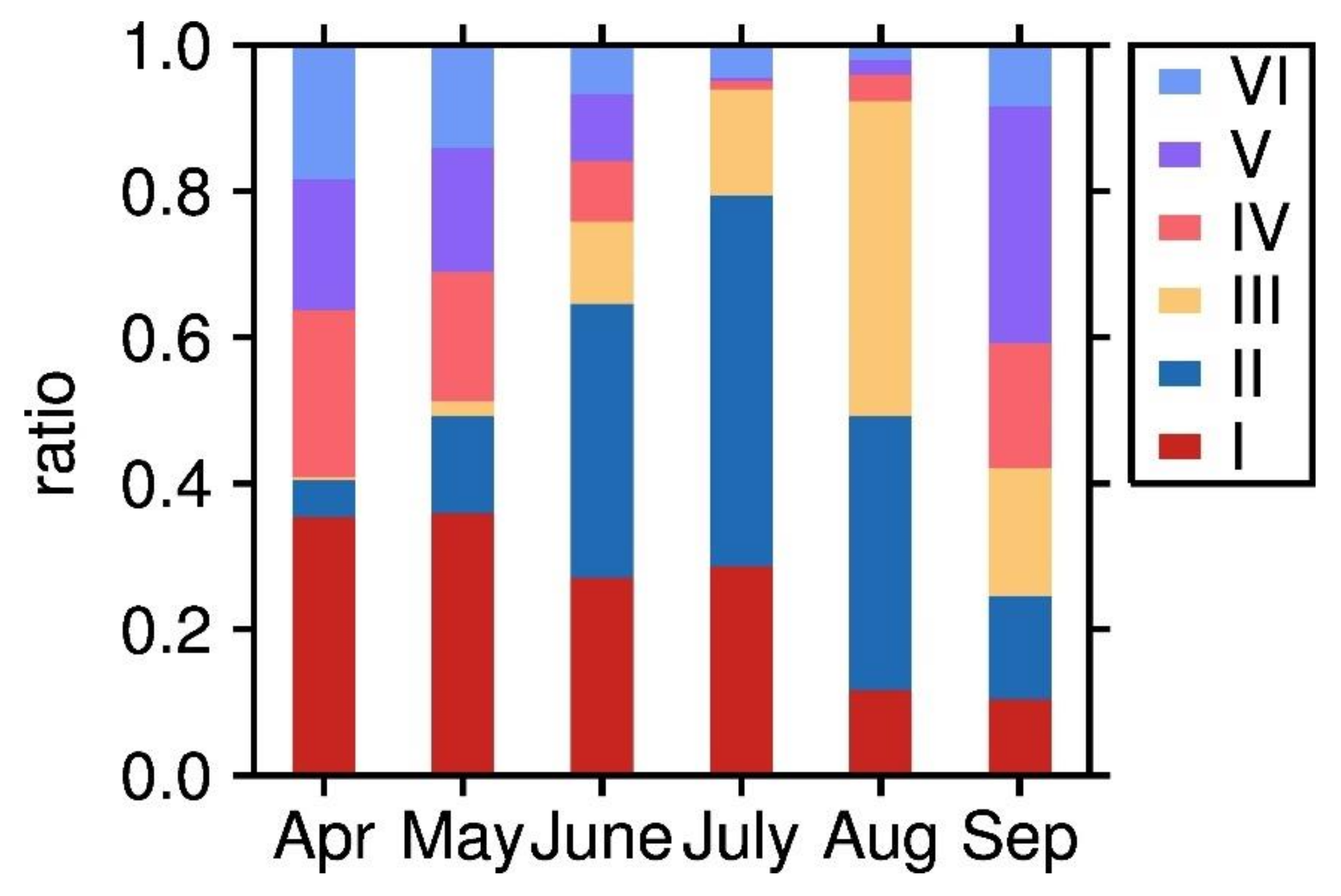
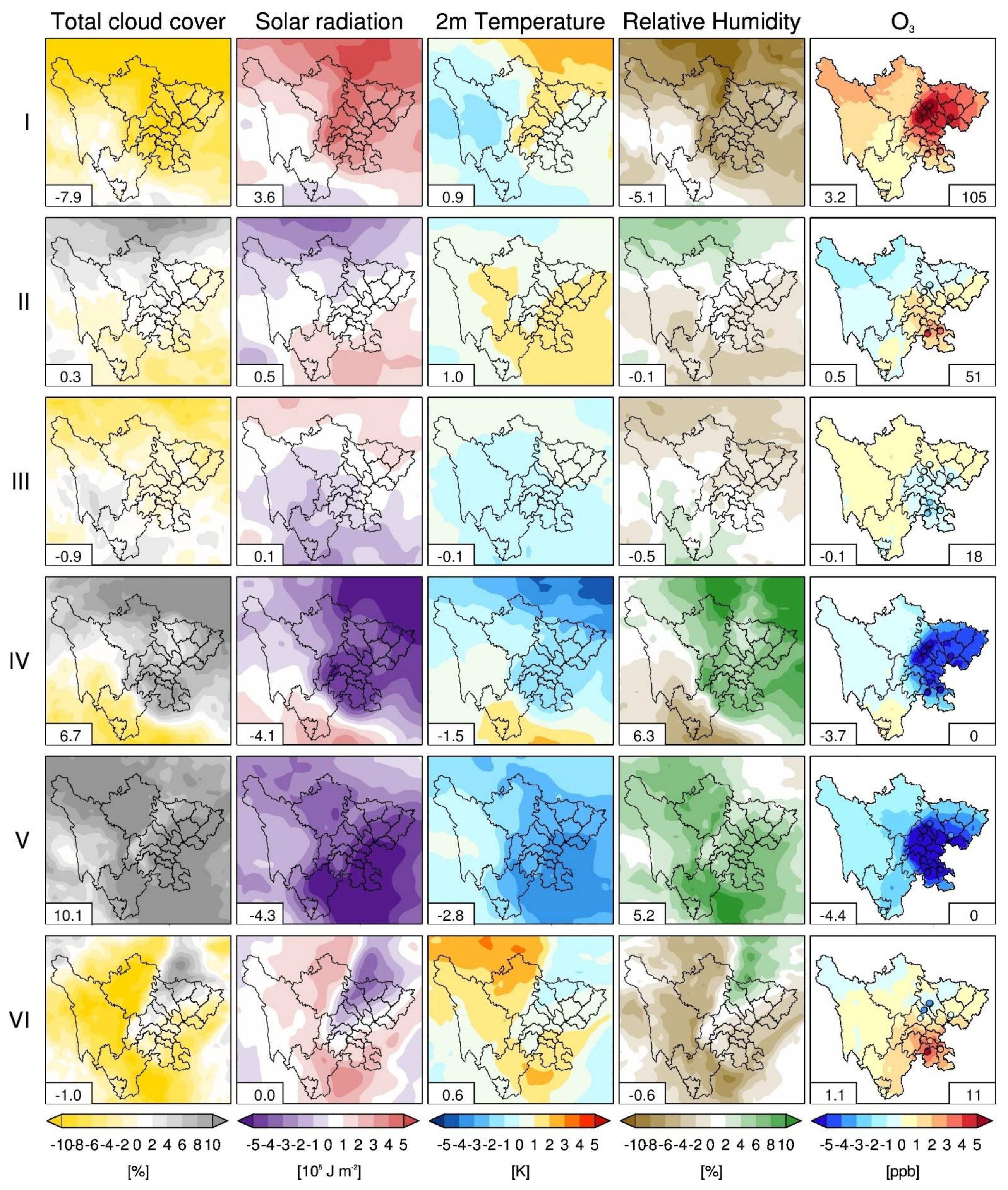
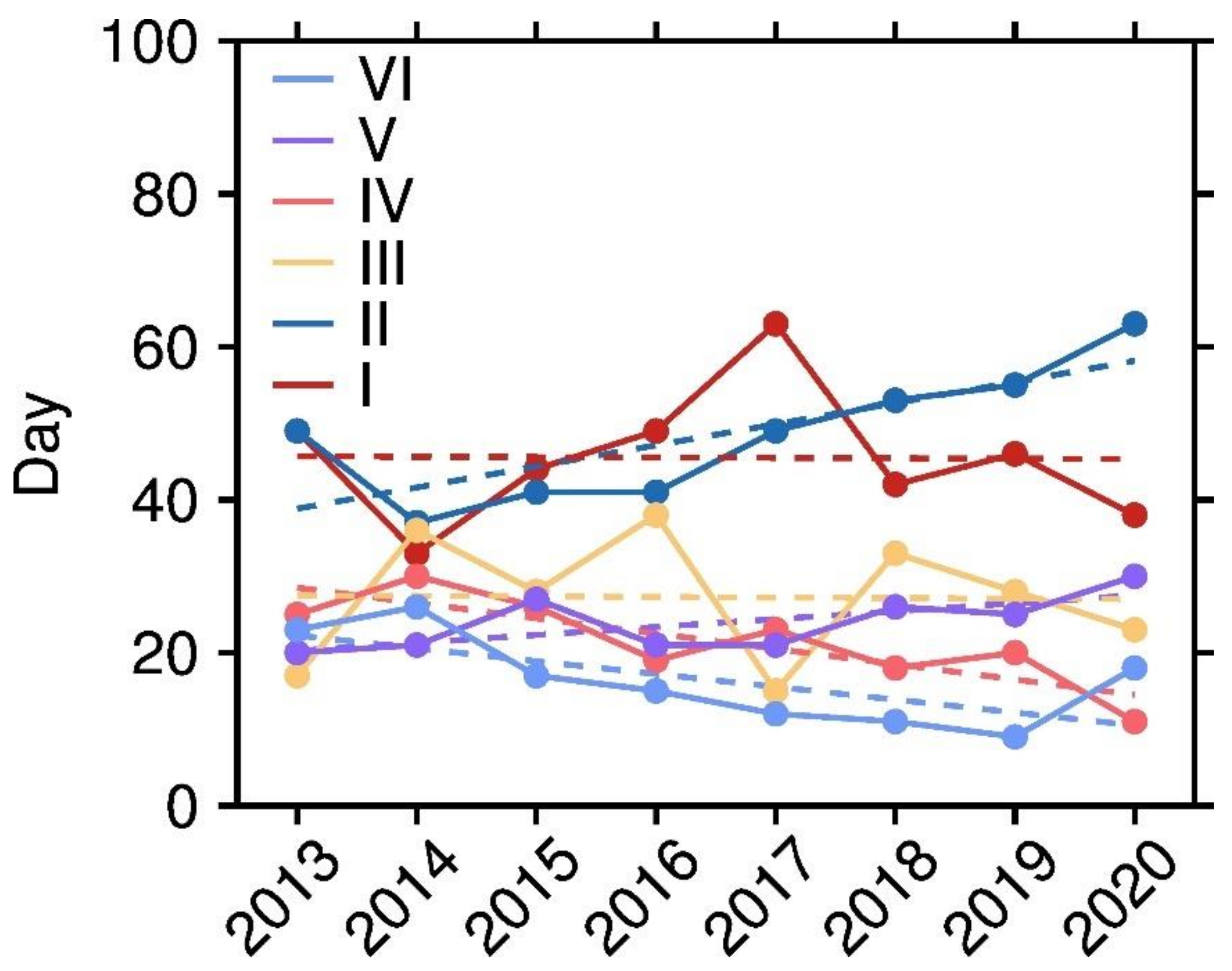
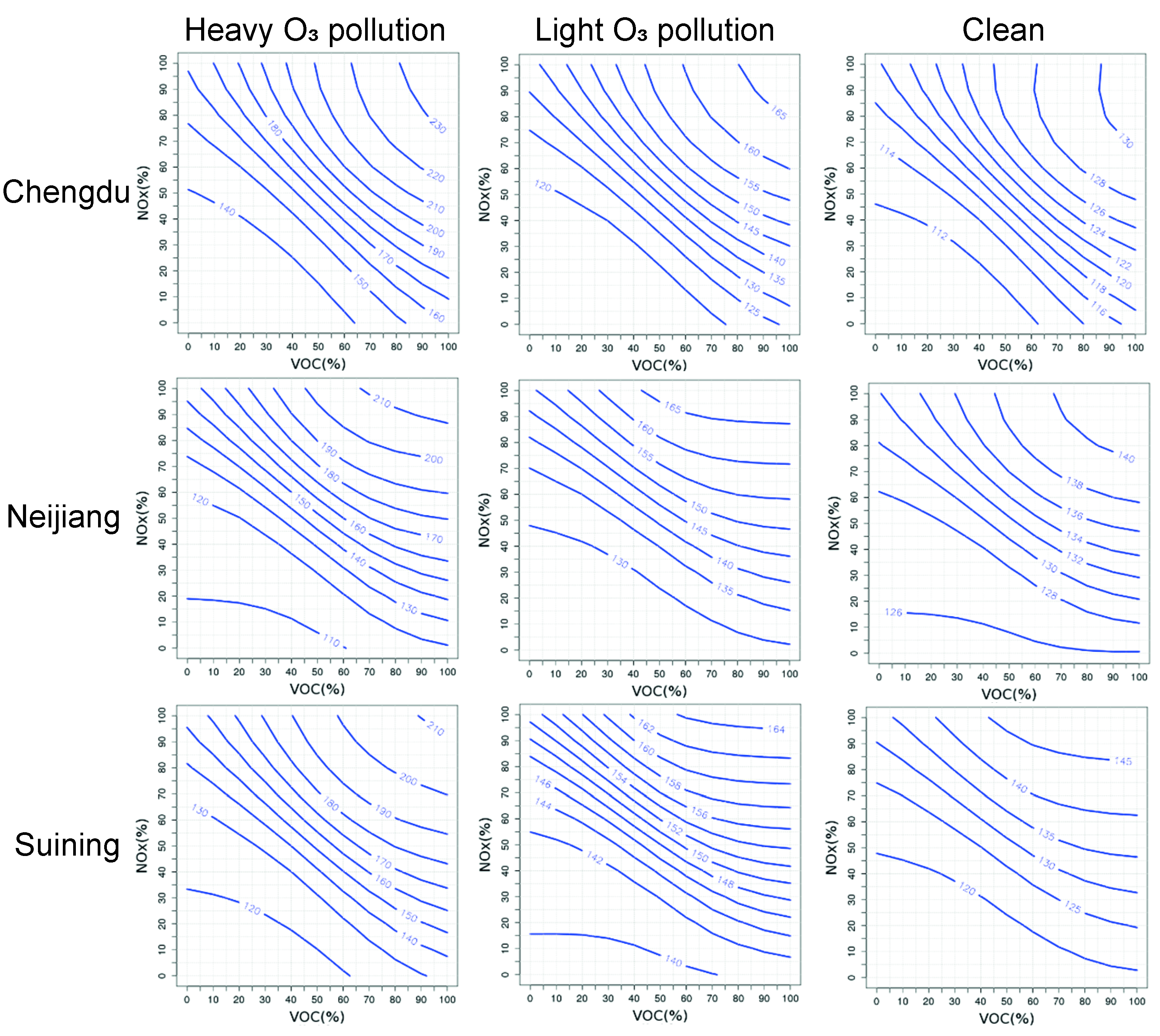
| O3 Formation Regimes | CD | DY | MY | LS | NJ | SN | YA | ZY | MS |
|---|---|---|---|---|---|---|---|---|---|
| NOx-limited | 27.3 | 81.8 | 76.2 | 77.3 | 85.7 | 90.5 | 95.5 | 90.9 | 90.5 |
| Transition | 31.8 | 4.5 | 14.3 | 13.6 | 4.8 | 4.8 | 0.0 | 4.5 | 9.5 |
| VOC-limited | 40.9 | 13.6 | 9.5 | 9.1 | 9.5 | 4.8 | 4.5 | 4.5 | 0.0 |
Publisher’s Note: MDPI stays neutral with regard to jurisdictional claims in published maps and institutional affiliations. |
© 2021 by the authors. Licensee MDPI, Basel, Switzerland. This article is an open access article distributed under the terms and conditions of the Creative Commons Attribution (CC BY) license (https://creativecommons.org/licenses/by/4.0/).
Share and Cite
Chen, Y.; Han, H.; Zhang, M.; Zhao, Y.; Huang, Y.; Zhou, M.; Wang, C.; He, G.; Huang, R.; Luo, B.; et al. Trends and Variability of Ozone Pollution over the Mountain-Basin Areas in Sichuan Province during 2013–2020: Synoptic Impacts and Formation Regimes. Atmosphere 2021, 12, 1557. https://doi.org/10.3390/atmos12121557
Chen Y, Han H, Zhang M, Zhao Y, Huang Y, Zhou M, Wang C, He G, Huang R, Luo B, et al. Trends and Variability of Ozone Pollution over the Mountain-Basin Areas in Sichuan Province during 2013–2020: Synoptic Impacts and Formation Regimes. Atmosphere. 2021; 12(12):1557. https://doi.org/10.3390/atmos12121557
Chicago/Turabian StyleChen, Youfan, Han Han, Murong Zhang, Yuanhong Zhao, Yipeng Huang, Mi Zhou, Cong Wang, Guangyan He, Ran Huang, Bin Luo, and et al. 2021. "Trends and Variability of Ozone Pollution over the Mountain-Basin Areas in Sichuan Province during 2013–2020: Synoptic Impacts and Formation Regimes" Atmosphere 12, no. 12: 1557. https://doi.org/10.3390/atmos12121557
APA StyleChen, Y., Han, H., Zhang, M., Zhao, Y., Huang, Y., Zhou, M., Wang, C., He, G., Huang, R., Luo, B., & Hu, Y. (2021). Trends and Variability of Ozone Pollution over the Mountain-Basin Areas in Sichuan Province during 2013–2020: Synoptic Impacts and Formation Regimes. Atmosphere, 12(12), 1557. https://doi.org/10.3390/atmos12121557







